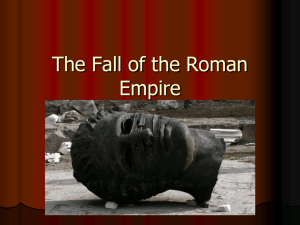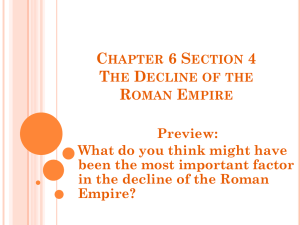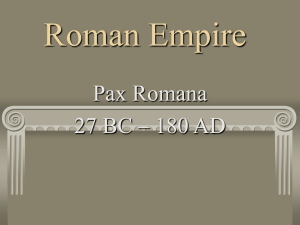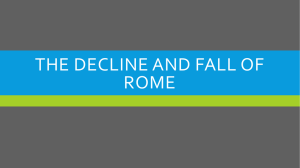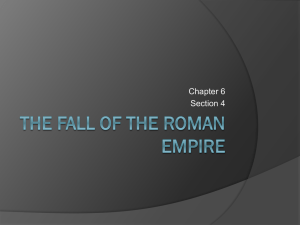The Fall of Rome
advertisement
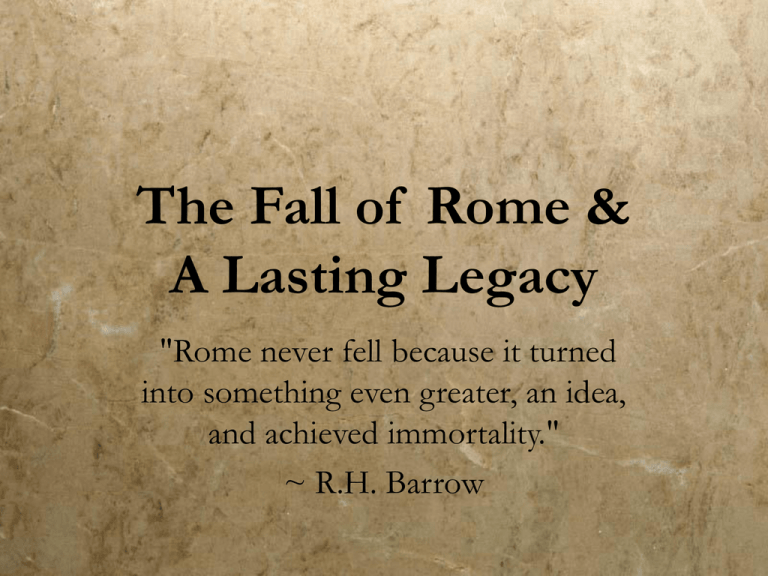
The Fall of Rome & A Lasting Legacy "Rome never fell because it turned into something even greater, an idea, and achieved immortality." ~ R.H. Barrow The End of Pax Romana After the rule of Marcus Aurelius in 180 CE, Pax Romana began to collapse and Rome went into decline. Weak economy: Hostile tribes on the borderlands and pirates threatened trade. There were no new sources of gold and silver, so the government raised taxes. By minting more and more coins with less precious metal, inflation occurredmoney was worth less and prices went up. Agriculture: The soil became overworked and produced fewer crops, leading to shortages and disease. Military and political upheaval: Soldiers had become less disciplined and loyal. The government needed to recruit mercenaries (foreign soldiers who fought for money). Eventually, feelings of loyalty to the empire weakened among regular citizens, who became indifferent to the fate of the empire. Diocletian and Reform Despite these problems, Rome survived for another 200 years. Emperors like Diocletian attempted to reform the empire. He limited personal freedoms, curbed inflation by setting prices and doubled the size of the army. He divided the empire into East (Greece, Anatolia, Syria, Egypt) and West (Italy, Gaul, Britain and Spain). He appointed a co-ruler for the West, but maintained over all control. After Diocletian’s death, civil war broke out. Constantine Constantine emerged victorious in the civil war and became the next emperor. He also reunited East and West. In 330 CE, Constantine moved the capital from Rome to the Greek city of Byzantium (it would be renamed Constantinople). The center of power shifted to the east from Rome. The new capital was strategically located, protected by massive walls and soon filled with imperial buildings and wealth. The Western Empire Declines Separated from the wealthier Eastern Empire, the West was soon weakened further by internal issues. Rome was also under threat from a new group, the Huns. These Mongol nomads swept in from central Asia and pushed various Germanic peoples closer into the Western Empire. Who were the Germanic peoples? The Germanic peoples had always lived on the borders of the Roman Empire to the north. They were actually many different groups, such as the Goths, Visigoths, and Vandals. Considered barbarians by the Romans, they migrated into Gaul, Spain and North Africa. Unable to field an army to stop them, Rome was plundered in 410 by Germanic tribes. Attila the Hun The Huns became a direct threat in 444, united under the chieftain Attila, who terrorized both halves of the empire. Unable to defeat Constantinople, Attila turned his attention to Rome. In 452, Rome narrowly escaped defeat as the Huns were weakened by famine and disease. End of the Empire The Romans continued to face threats from various Germanic tribes. The last Roman emperor, a 14 year old named Romulus Augustulus, was ousted by German forces in 476. After that, Roman power in the western half of the empire was dead. Meanwhile, the eastern half survived and flourished. It was known as the Byzantine Empire, preserving Greek and Roman culture. Invasions of the Western Roman Empire What caused the Western Roman Empire to Fall? Political causes: Political office was seen as a burden; military interference in politics; civil war; division of empire and moving the capital to Byzantium. Social causes: Decline in interest in public affairs; low confidence in empire; disloyalty; corruption; divide between rich and poor; decline in population due to food shortages. Economic causes: Poor harvests; disruption of trade; inflation; no more war plunder; taxes. Military causes: Threat from northern European tribes; low funds for defense; mercenaries; decline of loyalty among soldiers. Immediate cause: Invasions by Germanic tribes and Huns. What was the legacy of Rome? A legacy is what is left behind after an era comes to an end. The legacy of Rome is what is known as classical civilization- a mixture of Greek, Hellenistic and Roman elements that became known as GrecoRoman culture. This was a hybrid culture that not only included elements of the original cultures, but also created its own distinctive forms. It involved art, literature, science, law and other elements. Roman Fine Arts Roman art was more realistic and less idealized, intended to educate the public. Romans developed the baserelief form of sculpture, where images are projected from a flat background. Artists also created mosaics, which were pictures composed of small pieces of stone, glass and tile. Frescoes, large murals painted on wet plaster, were also a Roman specialty. Literature Romans borrowed much of their philosophy from the Greeks. Stoicism was particularly popular. They also took inspiration from Greek literature. Epics were popular, and a way for the Romans to promote their own themes and values. The poet Virgil wrote the Aeneid, the most famous piece of Latin literature. On a less serious note, the poet Ovid was famous for light, witty poetry. Rome also produced many historians. Livy was known for embellishing his history of Rome with myths, while Tacitus presented the facts accurately. Architecture and Engineering The Romans were known as master builders. The arch, the dome and concrete were all used to build massive structures. Arches supported bridges and aqueducts, which brought water into cities and towns. Roman roads were also technologically advanced, using stone, concrete and sand. The Colosseum is one of the most famous Roman buildings, which had a system of ramps, elevators, animal cages, concealed trapdoors, passageways and seats ringing a giant arena. The Colosseum Roman Law Romans believed that the law should be fair and apply equally to all people, rich and poor. The standards of law were influenced by teachings of Stoic philosophers and based on common sense and practical ideas. Basic principles included: all people had the right to equal treatment under the law; a person was innocent until proven guilty; the burden of proof should rest with the accuser, not the accused; a person is punished for actions, not thoughts; and any law that was grossly unfair should be set aside. Did Rome Really Fall? Some people believe that Rome did not actually fall, because it lived on in Western cultural tradition. Roman art, literature, architecture, technology, engineering and even language lived on as ideas and influences.

